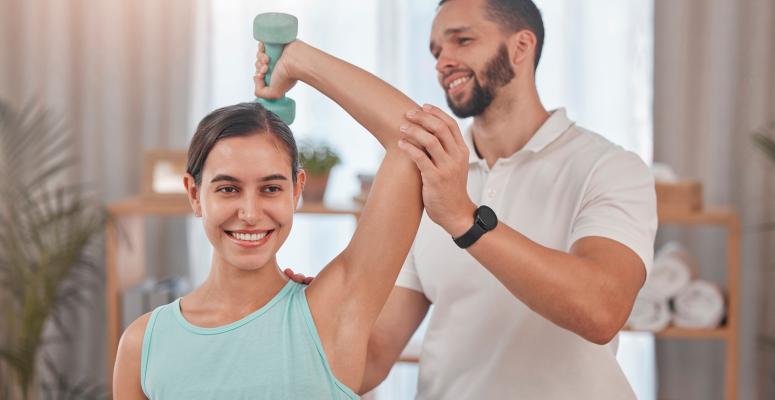
Exercising can have many benefits, from boosting your energy level to managing your weight. In addition, performing the proper exercises can play a crucial role in helping your body recover after an injury as well as restore the function of the affected area.
A separated shoulder is a common injury that can cause shoulder pain and reduced mobility. But with the proper physical therapy treatments, including targeted exercises, you can restore your shoulder’s range of motion, strength and flexibility. But what are the best rehabilitative separated shoulder exercises? That’s what we’re here to answer.
Read on to learn about the basics of a separated shoulder, how physical therapy can help with rehabilitation and the best separated shoulder exercises.
What is a separated shoulder?
An acromioclavicular joint injury, commonly referred to as a separated shoulder, is an injury that affects the acromioclavicular (AC) joint. The AC joint connects the end of your shoulder blade to the outer end of your collarbone, allowing you to raise your arm over your head. When the ligaments surrounding the AC joint are torn, the shoulder blade and collarbone can separate.
A separated shoulder is usually caused by blunt trauma to the shoulder, such as during a fall, car accident or playing sports. It can range from a mild tear to a complete separation.
Symptoms of a separated shoulder include:
- Severe pain following trauma.
- Reduced mobility.
- Swelling.
- Bruising.
- Deformed appearance.
How can physical therapy help your separated shoulder?
Physical therapy can play a crucial role in both recovery and rehabilitation after you sustain a separated shoulder. Not only can it help with pain management, but it can also help to increase the shoulder’s overall strength, flexibility and range of motion so that you can return to your everyday activities.
Physical therapy for a separated shoulder can combine a variety of treatment options, including therapeutic exercises and manual therapy.
The benefits of physical therapy for a separated shoulder include:
- Reduced pain.
- Restored mobility.
- Increased strength.
5 rehabilitative exercises for a separated shoulder
There are a plethora of exercises that a physical therapist can walk you through, but it’s important to perform targeted rehabilitative exercises that will directly benefit your separated shoulder. Your therapist can show you safe and effective exercises to restore your shoulder’s functionality, mobility and strength.
These exercises may require additional equipment, such as a wand. A wand refers to a long, thin cylinder, similar to the stick of a broom. Your physical therapist will tell you how many times to repeat each exercise.
Here are five separated shoulder exercises:
- Shoulder rolls — Sit or stand with your feet planted shoulder width apart. Move your affected shoulder in a circular motion: up, back and down. Repeat the movement as instructed by your physical therapist.
- Shoulder blade squeezes — Stand with your arms resting by your sides. Push your chest out so that your scapulas, or shoulder blades, are squeezed together. Hold for six seconds before returning to the resting position. Repeat as instructed by your physical therapist.
- Shoulder extension (standing) — While standing, hold a wand behind your back with both hands about shoulder width apart. Your hands should be facing away from your body so that the back of your hands are resting against your body. Move the wand as far out from your back as possible without pain. Hold for six seconds before returning to resting position.
- Shoulder flexion (lying down) — Lie down on your back with your feet planted on the floor and your knees bent toward the ceiling. Hold a wand in your hands and rest it on your thighs. Bring the wand back over your head until you feel a stretch in your shoulders, chest and upper back. Hold for as many seconds as instructed by the physical therapist, usually up to 30 seconds.
- Side-lying shoulder abduction — Lie down on your side so that your injured shoulder is facing up and your arm is resting on your side. Slowly raise your arm up and over your head while keeping your arm straight before bringing it back down. Repeat as directed by your physical therapist. They may recommend that you hold a weight during the exercise as your rehab progresses.
Alliance PTP is ready to help you find a caring partner to address your separated shoulder
Need a partner to help you address your separated shoulder? Alliance Physical Therapy Partners is here for you.
We can help you find the in-person or virtual physical therapy that’s right for you, and even better, we’ll help you find a team of caring professionals who are ready to walk with you through your entire PT journey.
Contact us today to start getting the care you need.
Get Help at a Location Near You
